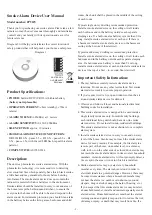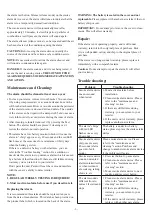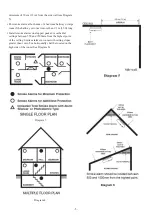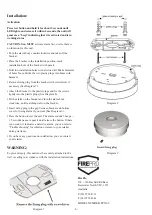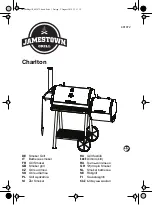
household member is hard of hearing, install special smoke
alarm devices with lights or vibrating devices to alert
occupants.
7: Smoke alarm devices can only sound their alarms when
they detect smoke or detect combustion particles in the air.
They do not sense heat, flame, or gas. This smoke alarm
device is designed to give audible warning of a developing
fire. However, many fires are fast - burning, explosive, or
intentional, and others are caused by carelessness or safety
hazards. In these circumstances smoke may not remake the
unit alarm QUICKLY ENOUGH to ensure safe escape.
8: Smoke alarm devices have limitations. This smoke alarm
device is not foolproof and is not warranted to protect
lives or property from fire. Smoke alarm devices are not a
substitute for insurance. Homeowners and renters should
insure their lives and property. In addition, it is possible for
the smoke alarm device to fail at any time. For this reason,
you must test the smoke alarm device weekly and replace
unit every 10 years.
Do Not Install Smoke alarm devices in
the Following Places:
1: Near appliances or areas where normal combustion
regularly occurs (kitchens, near furnaces, hot water
heaters). Use specialised smoke alarm devices with
unwanted alarm control for these areas.
2: In areas with high humidity, like bathrooms or areas near
dishwashers or washing machines. Install at least 3m away
from these areas.
3: Near air returns or heating and cooling supply vents. Install
at least 1m away from these areas. The air could blow
smoke away from the detector, interrupting its alarm.
4: In rooms where temperatures may fall below 5°C or
rise above 45°C, or in humidity higher than 85%. These
conditions will reduce battery life or cause a fault with the
alarm.
5: In extremely dusty, dirty, or insect-infested areas particles
may interfere with smoke alarm operation.
Operation:
Testing
Test the unit to ensure proper operation by pressing the test
button, this will sound the alarm if the electronic circuitry,
horn, and battery are working. If no alarm sounds, there is a
defective battery or other failures, you can refer to “Trouble
shooting” section for a solution.
DO NOT use an open flame to test your alarm, you could
damage the alarm or ignite combustible materials and start a
fire.
CAUTION: Due to the loudness (85 decibels) of the alarm,
always stand an arms-length away from the unit when testing.
Test the alarm weekly to ensure proper operation. Erratic or
low sound coming from your alarm may indicate a defective
alarm, you can refer to “Trouble shooting” section for
solution.
NOTE: WEEKLY TESTING IS REQUIRED.
LED indicators
Red LED-Flashing once every 40 seconds: indicates that the
smoke alarm device is operating properly.
Red LED-Flashing when the test button is pressed, or when
the smoke alarm device senses particles of combustion and
goes into alarm (constant pulsating sound), the red LED will
flash once per second. The flashing LED and pulsating alarm
will continue until the air is cleared or release test button.
Red LED-Alarm silencer (Hush mode) indication: The red
LED will flash once every 8 seconds, indicating the smoke
alarm device is in the alarm silence (Hush) mode.
Low battery indication - An intermittent “chirp” with red
LED flashes once every 40 seconds: indicates that the smoke
alarm device battery is low. You may press the test button to
silence alarm for 10 hours, but it will reset automatically after
10 hours.
Fault indication - The alarm chirp occurs every 40 seconds.
NOTE: When the units chirp once every 40 seconds, you can
press the test button to temporarily pause this warning tone
for 10 hours. Alarm can still normally detect smoke during
this period, it only removes nuisance warning tone. You can
refer to “Trouble shooting” for solution. If there are still a
failure, you MUST replace it with a new alarm at once or
contact your retailer during warranty period.
Alarm silence (silence mode)
If the unit is alarming, you can push the test button, to pause
the unit from alarming for approx 10 minutes. The red LED
will flash once every 8 seconds, indicating the smoke alarm
device is running in silence mode. Smoke alarm devices are
designed to minimize nuisance alarms. Combustion particles
from cooking may set off the alarm if the alarm is located
close to the cooking area. Large quantities of combustible
particles are generated from spills or when grilling/frying.
Using the fan on a range hood that vents to outside (non-
recirculating type) will also help remove these combustible
particles from the kitchen. The alarm silence (test button)
is extremely useful in a kitchen area or other areas prone to
nuisance alarms. The silence feature is to be used only when a
known alarm condition, such as smoke from cooking activates
the alarm. The smoke alarm device is desensitised by pushing
- 2 -

